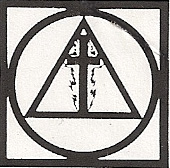St. Francis 1205
As the indolent summer of 1205 turned into autumn, Francis continued to work with his father in a kind of quiet, resigned desperation, unable to envision either a bright future or a chance at either knighthood or nobility.
Late one afternoon, he was returning from an errand to one of the properties his father owned outside the city walls, south of town. Having grown weary after hours of walking in the bright sunlight, he wandered into the cool refuge of San Damiano, which stood a mile from the city walls, at the foot of the hill on which Assisi was built. San Damiano was a small church, and over its doorway Francis could make out the faded words often inscribed in country chapels: Domus Mea (My House). Once inside, Francis sat alone, his eyes gradually adjusting to the dark.
The place seemed on the verge of collapse from old age and neglect. The walls were cracked, the low vault was crumbling, the beams were rotting. Wild grass sprouted along a narrow window, and the crescent-shaped apse, once bright blue with painted stars, was faded and peeling. No one had worshiped at San Damiano for years.
Over the abandoned altar, a crucifix had somehow survived the decay. Painted on linen stretched taut over a walnut frame, it was a striking image in the tradition of Syrian-influenced 12th century iconography, the eyes of Christ gazing serenely and directly toward the viewer.
In the stillness of the small church, Francis felt, as an early source described, “different from when he had entered.”
And then, “the image of Christ crucified spoke to him in a tender and kind voice: ‘Francis, don’t you see that my house is being destroyed? Go, then, and rebuild it for me.’
History offers many accounts of people catching glimpses of the world beyond, of being addressed by some unknown presence. Moses before the burning bush; Isaiah awed by his vision of the majesty of God’s court; Jesus aware of a profound sense of mission at the time of his baptism; the Buddha beholding the universe in a bouquet of flowers and Julian of Norwich seeing it in a hazelnut; Saints Paul and John astonished by unexpected visions; Saint Augustine hearing a child’s voice whisper, “Take up and read”—these moments changed the world and revealed the intersection of the timeless with time, of this world with another…
“He felt this mysterious change in himself,” Thomas of Celano concluded, “but he could not describe it. So it is better for us to remain silent about it, too.”..Francis could only interpret the message literally: he was sitting in a collapsing church, and he had been told to rebuild it. Immediately, he left San Damiano and set about finding ways to attend to its disrepair. Now at last, he had found a focus and a remedy for his present bewilderment…
Henceforth his life would no longer be centered on himself, his needs, his past, his pleasure, his pain, his glory, his fulfillment. From this time forward, he had one goal in mind: to remain accessible to the voice that had just addressed him—to enable the conversation to continue. Francis had been touched by the concrete image of the poor and humble Jesus, rejected and outcast, dying alone, convicted of perfidy and convinced that he had let God down. Francis wanted to be warmed and embraced forever by that touch.
– from The Reluctant Saint by Donald Spoto
